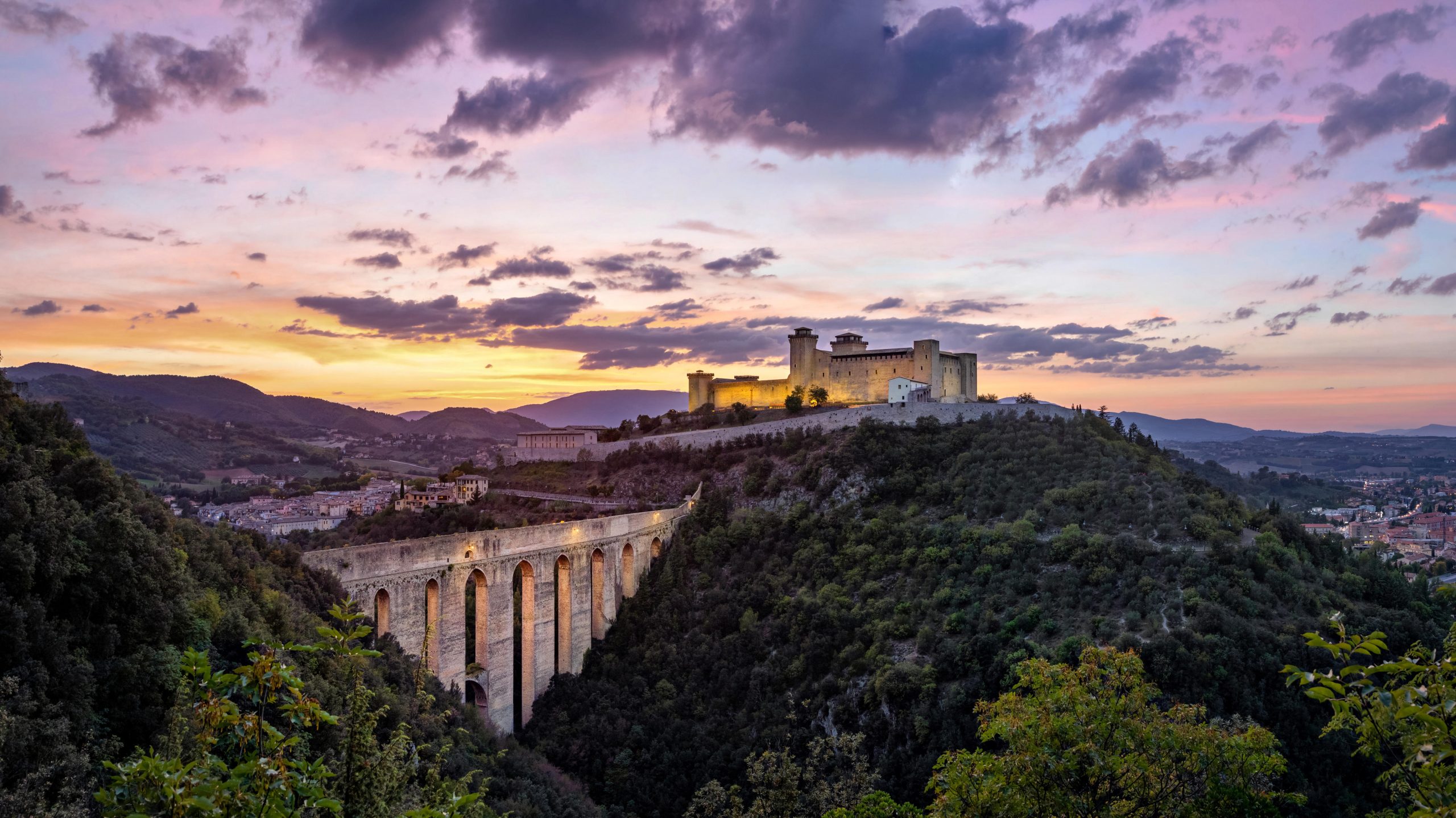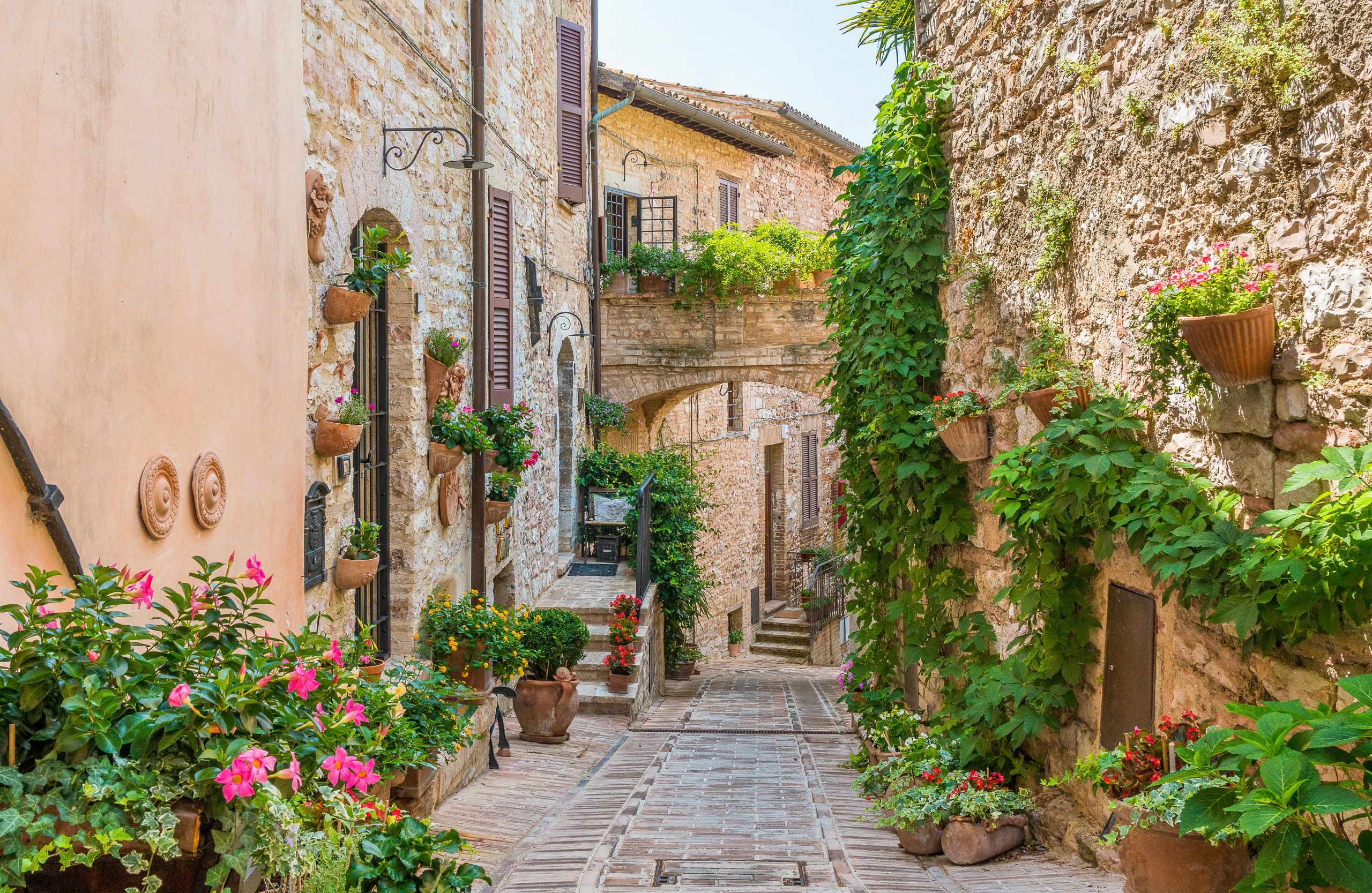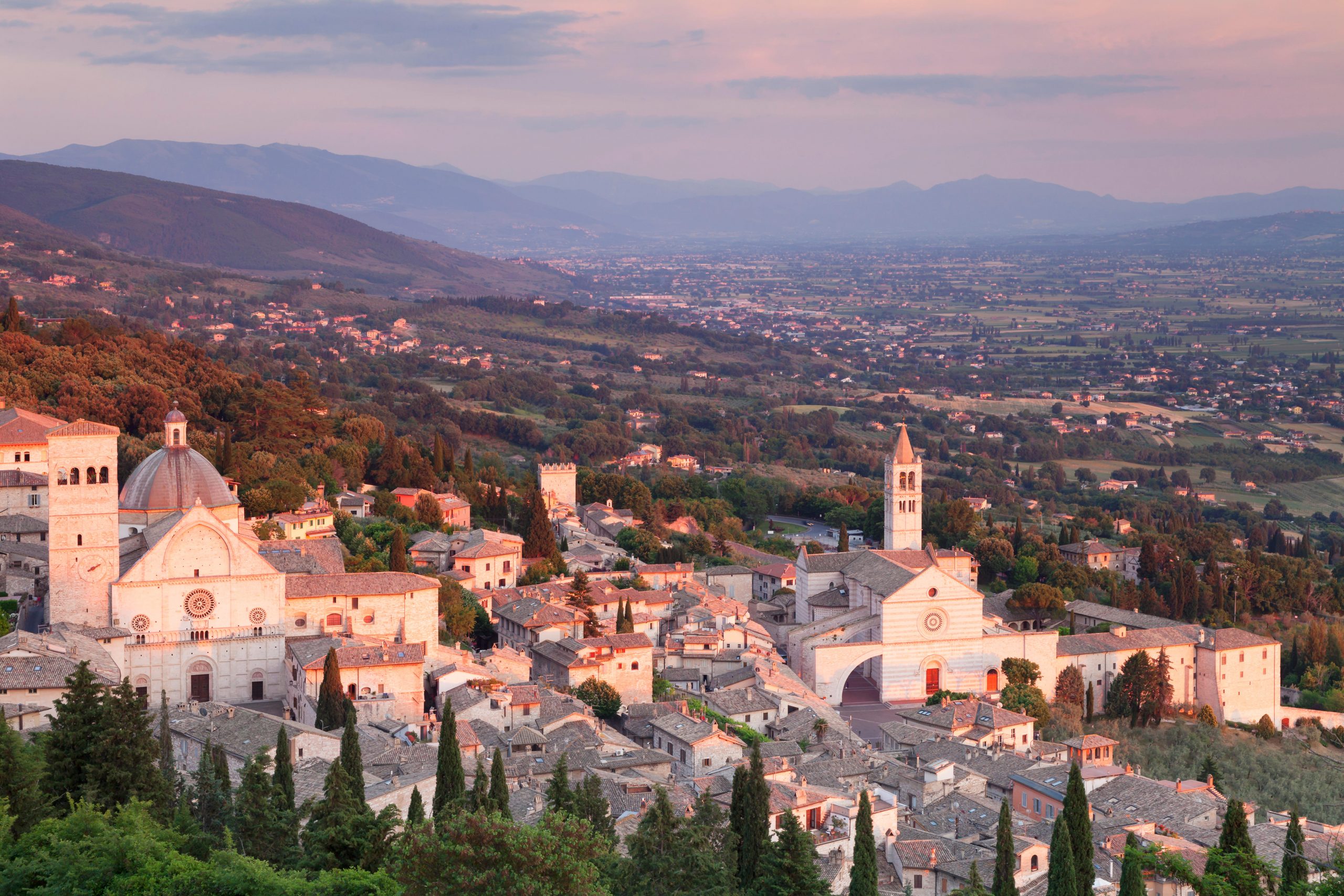Perugia and rural Umbria: Where to go, what to see, and the best places to eat, drink and stay
Mary Miers explores what the capital of Umbria and its surrounding hilltowns have to offer.


In the Umbrian capital of Perugia, smart-suited accountants emerge from Gothic doorways. Young executives drop by Madonna della Luce for a lunchtime prayer. A design studio occupies a vaulted undercroft, Max Mara a Renaissance palazzo.
The captivating fusion of ancient and modern is what makes Umbria, and Perugia in particular, such an attractive place to visit (and, in some cases, to live).
And beyond Perugia's ancient confines, there are plenty other hilltop towns to explore — each as interesting and historic as the next.
Perugia

Built on a series of rocky spurs, Perugia is a city of layers spanning 2,000 years. Descend beneath the cathedral cloister into a labyrinth of ancient structures and walk along a subterranean road scored with Roman wheel ruts. Just when you think you’ve grasped the layout of the acropolis and its temple, medieval brickwork crashes into an Etruscan wall, setting off in a different direction.
Later layers include the great monastic churches, noblemen’s houses (now shorn of their towers) lining canyon-like medieval streets, elegant Renaissance thoroughfares and the bulwark of the papal fort, Rocca Paolina, with medieval Via Baglioni, still a busy thoroughfare, subsumed within.
Created above it after the fort was destroyed is Piazza Italia, surrounded by grand buildings of the Risorgimento, and the Carducci gardens looking out to the distant Apennines. The gentle landscape that rolls out beyond the undulating rooftiles of Perugia is that of late Gothic paintings; in places it comes right up to the city gates.
Rustic Umbria may have less Renaissance bling than its smarter neighbour Tuscany, but here are some of the best preserved medieval towns in Italy, each with its diminutive civic square like a stage set. I lost count and kept changing my mind as to my favourite. Wracked by endless feuding between Guelphs and Ghibelines and shaken by earthquakes, these jewels of Umbria have survived, small enough to explore on foot and unencumbered by cars — or even tourists off season.
Exquisite houses, the beauty of Nature, and how to get the most from your life, straight to your inbox.
Best hotels in Perugia
Sina Brufani is Perugia’s only five-star hotel, was opened in 1884 by Giacomo Brufani, pioneer of Umbrian tourism. A favourite of the British, who stopped here en route to Rome, it’s still a bastion of old-world grandeur, albeit with a glass-bottomed pool.
Locanda della Posta overlooks the grand main thoroughfare Corso Vanucci, and was founded in 1786 as Perugia’s first hotel. Its has recently been remodelled as a stylish boutique hotel.
Hotel Fortuna occupies a frescoed house dating back to 1300 in Via Bonazzi, one of the medieval streets reached by even narrower alleys leading down from Corso Vanucci.
Where to eat in Perugia
Atmospheric, unpretentious restaurants with good local menus and wines include Osteria a Priori and Bottega del Vino. For central cafes serving excellent coffee, try the frescoed Pasticceria Sandri on Corso Vannucci (established 1860) or Turan on Piazza IV Novembre, with more frescoes and outstanding chocolates. Gelateria Gambrinus in Via Luigi Bonazzi has the best ice-cream.
Città della Pieve

The setting of this unsung gem perched above the Chiana valley near Tuscany is straight from a painting by Perugino, who was born here around 1450.
Unusually built of brick since the 13th century, its peaceful streets invite wandering, with charming shops and cafés and views from the encircling walls. Perugino’s legacy includes the duomo’s Madonna in Glory altarpiece (above) and Baptism of Christ, and the Oratorio di Santa Maria dei Bianchi’s Adoration of the Magi, a fresco of 1504 preserved with two of his letters found in 1835.
Where to stay in Città della Pieve
Hotel Vannucci is an elegant villa built by Vittorio Emanuele II’s daughter, who eloped here with her lover. A hotel since 1903, it’s decorated with a mix of antiques and modern furnishings and has a garden terrace with pool. This is the perfect base from which to explore Lake Trasimene, with its outstanding fortress town of Castiglione del Lago.
Where to eat in Città della Pieve
Zafferano Ristorante serves the best regional fare and wines.
Spoleto

Strategically sited on the Via Flaminia, Roman Spoleto survived an attack by Hannibal in 217BC, and by 580 was established as an important duchy. The town’s attraction today is its air of faded grandeur, with steep cobbled streets lit by old-fashioned lamps leading to squares lined with peeling palazzi and proper, useful shops.
The Duomo is one of the loveliest in Umbria, with eight filigree rose windows, a mosaic and two pulpits adorning its pink and white façade and an apse frescoed with the final masterpiece of Filippo Lippi. Spoleto also has notable Roman remains and a group of outstanding Romanesque churches.
Dominating all is the 14th-century fortress, visible from afar and with its own unmissable views over the Valle Umbra and down to the magnificent aqueduct, Ponte delle Torri (main image), spanning a wooded ravine.
Founded in 1958, Spoleto’s world-famous music and opera Festival of the Two Worlds is held in late June.
Where to stay in Spoleto
Hotel Clitunno in the historic centre; its award-winning San Lorenzo restaurant is also excellent.
Where to eat in Spoleto
Ristorante Apollinare, where owner/chef Giuseppe Sinisi has introduced modern elegance to a 13th-century house off Piazza della Liberta to provide the best Umbrian gastronomic experience. He has revisited the traditional cuisine to create an array of imaginative dishes (including Spoleto specialities), using local cheeses, olive oils, truffles, vegetables, meats, flowers, homemade pastas and ice-creams. Wines come from the Montefalco vineyards, praised by Pliny as the best in Italy.
Spello

Encircled by 1.2miles of Augustan walls (still with intact towers), this picture-postcard town climbs uphill from the arched gateway of Roman Hispellum to the 1320 monastery at its summit. Running up its spine between narrow streets of pink and white stone houses bedecked with flowers is Via Cavour, flanked by notable civic and religious buildings and opening out into two charming piazzette.
Santa Maria Maggiore, with its late frescoes by Perugino, houses an exquisite cycle by his pupil/partner Pinturicchio, who also painted the splendid altarpiece in Sant’ Andrea up the road. More by the 13th–16th-century Umbrian School of painters in the Pinacoteca Civica. Just outside Porta San Sisto, the Villa dei Mosaici museum houses 5,381sq ft of mosaics discovered here in 2005.
Comprising 10 floors of a Roman villa that was destroyed by fire in the 5th century, they can be seen in situ with fragments of fresco, alongside Roman artefacts and multi-media reconstructions of the villa.
Where to stay in Spello
Hotel Bastiglia and Spa occupies a 17th-century complex filled with antique furniture, ceramics and sculptures, set among olive trees at the highest point of the little town with wonderful views to Assisi and Monte Subasio.
Where to eat in Spello
The olive oil specialist restaurant/shop, Extra Vergine Oleoteca in Via Garibaldi, and La Cantina further up the hill, serve good food in atmospheric settings.
Assisi

Presided over by Rocca Maggiore, medieval Assisi was built over Asisium, terraced up a spur of Monte Subasio. The finest Roman survivals are the pedimented façade of the Temple of Minerva in Piazza del Comune (site of the forum) and a (now subterranean) house with exquisite bird frescoes.
Since 1250, the town’s principal focus has been the double-decker Basilica of St Francis, who was born here in 1182. His life inspired great painters — Cimabue, Giotto, Martini and Lorenzetti — to decorate the interiors with frescoes of unrivalled significance to the story of Italian art. Assisi’s other great basilica is dedicated to Santa Chiara, friend and follower of St Francis and founder of the Poor Clares. Continuing the Franciscan theme is the Porziuncola Museum on the plain below, where the order was first based.
Where to stay in Assisi
Hotel Fontebella is a Renaissance palazzo above San Pietro, with a dining terrace and wonderful views across the Valle Umbra. Il Frantoio (open to non-residents) serves excellent dishes created by chef Lorenzo Cantoni from Umbrian recipes and ingredients
Where to eat in Assisi
Ristorante San Francesco, founded in 1945 and still run by the Angeletti family, offers traditional Umbrian cuisine overlooking the Basilica. The establishment also includes a large, elegant café bar.
Gubbio

Heading north from Perugia through hills dotted with oakwoods and olive groves backed by the Monti Sibillini, Gubbio comes into view as a series of gleaming terraces on Monte Ingino, surmounted by a fort and the hilltop basilica of Sant’ Ubaldo (accessible by cable car). The city where St Francis tamed a wolf was founded as Iguvium in the 3BC and preserves the astonishing bronze Iguvine tablets of the Umbri, unearthed in 1444. It later came under the rule of Federico da Montefeltro, Duke of Urbino, who was born here in 1422 and commissioned Martini’s Renaissance remodelling of the Palazzo Ducale, with its beautiful courtyard of grey pietra serena. Below is the superb ensemble of Palazzo dei Consoli (1330s) and Palazzo del Podesta (1350), facing each other across the balustraded terrace of Piazza Grande, with its breathtaking panorama. Attributed to Gattapone, the former is one of Italy’s best preserved medieval public buildings, complete with original plumbing and mural stairs; it now houses the civic museum. Gubbio is renowned for its ceramics, notably the ruby majolica developed by Andreoli around 1500, and it retains its tradition of craftsmanship, as well as a stronger than usual sense of community.
The Festa Dei Ceri (with pagan origins) is held on May 15 (the eve of St Ubaldo’s feast day), its most famous spectacle the annual race up Igino carrying heavy wooden floats.
Where to stay in Gubbio
Hotel Relais Ducale is a characterful complex of ranges on different levels around a garden terrace, including an old palazzo with a roof garden and secret tunnel.
Where to eat in Gubbio
Taverna del Lupo, which has occupied the extensive vaults of a 14th century house for 50 years, is the local favourite. Homely and individual, it serves simple but delicious dishes in a vibrant setting full of local artworks, ceramics, cabinets of curios and confectionery stands.
Local specialities include a pie of potatoes, funghi, porcini and crema di pecorino, and del Lupo’s own lasagne croccante. Almond tozzetti (biscuits) with sweet Vin Santo is an Umbrian staple, as are meringue-like ‘Ganachoni’.
Find out more about the region at the Umbrian tourist board website.

Credit: Alamy
Two middle-aged ladies, one beautiful Fiat, and a magical week in Umbria
Mary Miers teamed up with an old friend as she visited one of Italy's most enchanting regions.

A weekend (or longer) on Skye, Scotland: What to do, where to eat, where to stay
How to make the most of one of Scotland's most beautiful islands, by Mary Miers.
Mary Miers is a hugely experienced writer on art and architecture, and a former Fine Arts Editor of Country Life. Mary joined the team after running Scotland’s Buildings at Risk Register. She lived in 15 different homes across several countries while she was growing up, and for a while commuted to London from Scotland each week. She is also the author of seven books.
